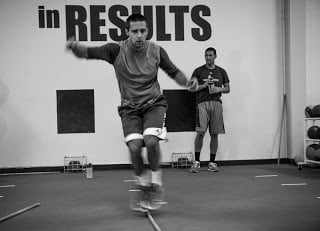
We have previously introduced the concept of Reactive Strength. Along with Maximal Strength and Strength Endurance, Reactive Strength is one of the primary methods that we use to elicit Movement Signature adaptations.
Reactive Strength is the ability to absorb force in one direction, and rapidly apply more force in the opposite direction (quickly switch from eccentric to concentric). We divide reactive strength into three categories based on their type of ground contact.
Short: brief contact times and large amounts of force
Long: elongated contact times and more moderate amounts of force with each contact
Non-Impact: acceleration/decelerate external load (Versa pulley) without ever leaving the ground
Lateral line jumps are a Short Reactive Strength movement that emphasizes the lateral plane. Athletes must maintain body position, stiffness, and rhythm in order to maximize height and distance on this movement.
Feet together
Anticipate contact and “brace”
Recycle force by creating rhythm with the arms
For athletes who need EXPLODE, lateral line jumps are paired with a deadlift. By complexing these two movements, we are able to train complimentary movement qualities that will address this athletes’ Movement Signature needs. One of the best ways to get better at a movement is to understand why you are doing it. Next time you drop a plyo into your program, think about how you would categorize it, and which specific movement qualities you are trying to address (short, long, or non-impact).